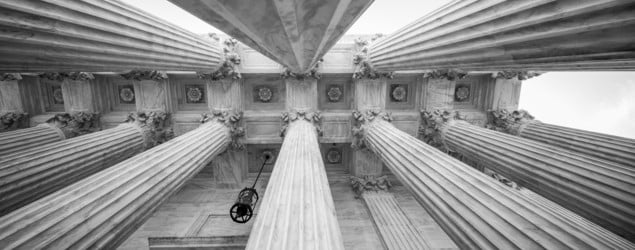In SCOTUS Abortion Case, Both Liberals and Conservatives Undercut Themselves

On March 2, 2016 the U.S. Supreme Court heard a case challenging a Texas law regulating access to abortion. Unlike the kind of abortion laws that were struck down in Roe v. Wade, which outlawed abortion directly, this case challenges a law that indirectly restricts access to abortions by going after doctors and clinics. The Texas law does this by imposing restrictions on which doctors can perform abortions and in which facilities abortions can be performed. For example, it requires doctors who perform abortions to have admitting privileges at local hospitals, and it requires abortion clinics to meet the standards of ambulatory surgical centers.
What makes the case noteworthy is that it puts the traditional political sides at odds with legal principles they have long advocated. Liberals have traditionally supported broad government power to regulate the economy — for example, through occupational licensing laws and general business regulations — and they have advocated limiting the power of judges to overturn such laws. Yet, in this case, they are opposing what in any other context would be seen as an economic regulation — a regulation on the qualifications of doctors and medical facilities. Conservatives and libertarians, meanwhile, have typically opposed economic regulations and they increasingly see it as proper for judges to overturn such laws under the constitution. Yet, in this case, many on the right are supporting what in other contexts would (and should) be seen as a pointless restriction on a doctor’s right to pursue his or her profession and to do business with willing customers.
The challengers in the case point out that the law’s requirements would force all but seven to ten of the facilities providing abortions in Texas to close — down from forty-one in 2012. The reason the clinics are closing is simple: placing expensive and burdensome requirements on abortion providers makes it more costly and difficult to provide abortion services. In this case, more than half of the abortion providers determined that it would be better to shut their doors than to attempt to meet the state’s arbitrary requirements. And the requirements are arbitrary. One friend-of-the-court brief, filed jointly by the American Medical Association and several other medical organizations argues that the ambulatory surgical center requirement “is devoid of any medical or scientific purpose.” The brief points out that abortions already have a very low mortality rate — according to the CDC, less than one death per 100,000 procedures over the last several decades — and a low risk of complications. There’s no evidence that the procedures are safer when performed in ambulatory surgical centers. The same brief explains that no Texas law “requires colonoscopies or liposuction to be performed in an [ambulatory surgical center] or hospital setting and the mortality rate for both procedures is higher than abortion.” In short, the obvious purpose of the Texas law (versions of which a number of other states have passed as well) is to make it harder to obtain abortions.
Indeed, many commentators who have supported the law have admitted as much. One example is David Dewhurst, who was Texas lieutenant governor when the law was passed in 2013. The day after the law was passed in the Texas Senate, Dewhurst, who has described himself as “unapologetically pro-life,” made it clear on Twitter that the law was not about protecting women’s health. Another example came from the state’s solicitor general, who announced during litigation over the law that “[a] law that is enacted to advance the State’s interest in the life of the unborn need not be medically necessary.”
Translating all of this into constitutional terms, the basic question in this case is whether a state can impose a restriction on a profession, when the state’s real purpose is to restrict the exercise of a constitutionally protected right that the profession helps individuals to exercise. In short, can states impose an indirect restriction on a right because they don’t think they can get away with imposing a direct restriction on that right?
The reason that states are attempting to regulate abortion in this way is that federal courts apply a stricter constitutional standard to laws that restrict the right to have an abortion, but a much more lenient standard to laws that regulate economic and property rights. Since about the late 1930s, the Supreme Court has allowed government to impose economic regulations so long as the law is “rationally related” to proper government purposes. “Rational” in this context, does not really mean rational in the way any sensible person would use it — it means something closer to “not crazy.” And government purposes are construed so broadly as to include practically anything government wants to do. (As an example, a few courts have held that explicit economic protectionism — preventing one business from operating in order to favor another business — is a proper government purpose.) The result, to paraphrase law professor Richard Epstein, is that a law typically won’t violate the rational basis standard unless the legislature was insane when the law was passed.
At the same time that the Supreme Court has allowed rampant regulation of economic and property rights, it has also held that a stricter standard should apply to laws that regulate so-called “fundamental” rights, which include free speech and abortion, among others. For those rights, a law must serve a compelling government purpose and not be any broader than necessary to accomplish that purpose in order to be upheld. Most laws are struck down under this standard.
So as we noted, this all puts both liberals and conservatives on the horns of a dilemma. To oppose this law, liberals have to oppose what they have long supported, which is broad power in government to regulate economic and property rights. Conservatives, meanwhile, have to support broad power in government to regulate economic rights that many of them have rightly complained are treated as constitutional second-class citizens.
Both liberals and conservatives are at fault for this fractured and contradictory approach to law and government. Liberals have long championed unlimited economic regulation, while believing that they could carve out protections for certain rights (e.g., speech and abortion) that they deemed fundamental. This case, and the calls by many liberals for greater power in government to regulate free speech, gives the lie to that approach. Conservatives, meanwhile, decried the growth of government and its domination of the economy even while lamenting the role of courts in enforcing limits on legislatures. They embraced “judicial restraint” as the operating model for courts in constitutional cases, meaning that courts should give maximum deference to the elected branches of government to manage and regulate the affairs of citizens. “For protection against abuses by legislatures,” the Supreme Court has long maintained, “the people must resort to the polls, not to the courts.” Chief Justice John Roberts embraced that basic approach in his 2012 decision upholding Obamacare’s individual mandate. Most conservatives were outraged by that decision because it allowed government to override our right to make choices about our own medical care. Today, however, many of the same conservatives are embracing a law that allows government to do the same thing in the context of abortion.
As Ayn Rand pointed out in her essay For the New Intellectual, “[a] free mind and a free market are corollaries.” The freedom to live one’s life requires the freedom both to think and to act. It’s not enough to be free to speak or to make intimate choices about one’s own body. If one is denied the right to use the means to implement one’s ideas and choices, then those ideas and choices are not free. To exercise the right to free speech, for example, we need to be able to buy computers, Internet services, paper and printing presses. (For a good example of this principle in action, look to Venezuela, where government-caused shortages of newsprint has amounted to a de facto limit on freedom of the press.) Likewise, if women are to exercise the right to have abortions, they must be able to engage the services of doctors and other health care providers. But how safe will anyone’s right to abortion be when governments are free to regulate doctors and health care facilities (or any other business) in any way they please?
It’s tempting to wish that both sides in this case could lose, but that would mean that innocent individuals — women who want abortions and doctors who want to provide them — would be prevented from exercising their rights and pursuing their happiness as American law and government are supposed to allow. Although it is not clear from the oral arguments in the Supreme Court who will prevail, what is unfortunately clear from this case and many others is that most liberals and conservatives oppose the American approach to government and the Enlightenment ideals that underlie it. Those ideals require one to recognize that true freedom means freedom of thought and freedom of action. It means that any attempt to divide up rights between favored and disfavored (which over the years has manifested itself in expressions such as civil rights vs. economic rights, the rights of business vs. the rights of labor, property rights vs. human rights, and, in the courts, fundamental rights vs. non-fundamental rights) will ultimately mean the destruction of all rights.
The only fundamental right is the right of the individual to live his life as he sees fit, so long as he respects the rights of others. That includes the right to speak as you wish, to control your own body, to have abortions, to contract with others, to charge whatever prices you wish for your goods, and to own and use your property as you see fit. It is just as morally repugnant to forcibly prevent women from having abortions or contracting with the doctors of their choice for that service as it is to compel people to purchase insurance or to force Christians to bake wedding cakes for gay couples. And it is morally repugnant to embrace a rule of law in which courts pretend to be applying a standard that everyone knows is a sham, especially when that results in upholding a law whose stated purpose — protecting health — is obviously different from its actual purpose — preventing abortions.



